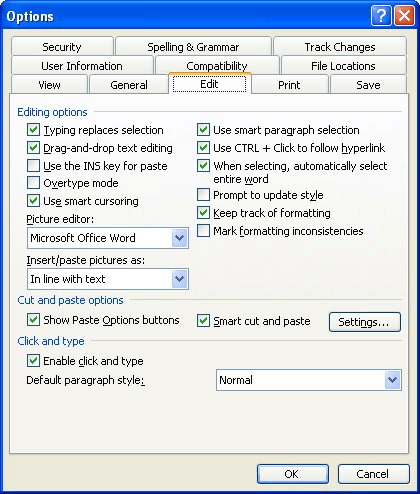Please Note: This article is written for users of the following Microsoft Word versions: 97, 2000, 2002, and 2003. If you are using a later version (Word 2007 or later), this tip may not work for you. For a version of this tip written specifically for later versions of Word, click here: Extra Space after Quotation Mark when Pasting.
Written by Allen Wyatt (last updated October 1, 2020)
This tip applies to Word 97, 2000, 2002, and 2003
Richard cuts and pastes quotations quite a bit. If he types a quotation mark and then pastes text right after the quotation mark, Word automatically puts a space between the quotation mark and the text he's pasting. Richard then has to go back and delete the added space. He wonders how he can stop this behavior in Word.
Actually, the behavior is "by design" in Word. It is part of what Microsoft refers to as "smart cut and paste." It means that Word tries to figure out whether it should add or subtract a space from things you are cutting or pasting. This can, for some people and some purposes, cause confusing results.
You can turn off smart cut and paste (and thereby stop Word from adding the unwanted space after the quotation mark) by following these steps:

Figure 1. The Edit tab of the Options dialog box.
If you prefer, you could leave the check box selected (in step 3) and simply modify what things smart cut and paste does for you.
WordTips is your source for cost-effective Microsoft Word training. (Microsoft Word is the most popular word processing software in the world.) This tip (8757) applies to Microsoft Word 97, 2000, 2002, and 2003. You can find a version of this tip for the ribbon interface of Word (Word 2007 and later) here: Extra Space after Quotation Mark when Pasting.

Create Custom Apps with VBA! Discover how to extend the capabilities of Office 365 applications with VBA programming. Written in clear terms and understandable language, the book includes systematic tutorials and contains both intermediate and advanced content for experienced VB developers. Designed to be comprehensive, the book addresses not just one Office application, but the entire Office suite. Check out Mastering VBA for Microsoft Office 365 today!
Three of the tools provided in Word are AutoText, AutoCorrect, and AutoComplete. It is easy to confuse what these tools ...
Discover MoreOne of the most common symbols that can be added to a document is the copyright mark. This tip examines several ways you ...
Discover MoreIf you use justified paragraphs, you know that if you press Shift+Enter, it can lead to some odd spacing between words ...
Discover MoreFREE SERVICE: Get tips like this every week in WordTips, a free productivity newsletter. Enter your address and click "Subscribe."
There are currently no comments for this tip. (Be the first to leave your comment—just use the simple form above!)
Got a version of Word that uses the menu interface (Word 97, Word 2000, Word 2002, or Word 2003)? This site is for you! If you use a later version of Word, visit our WordTips site focusing on the ribbon interface.
Visit the WordTips channel on YouTube
FREE SERVICE: Get tips like this every week in WordTips, a free productivity newsletter. Enter your address and click "Subscribe."
Copyright © 2026 Sharon Parq Associates, Inc.
Comments